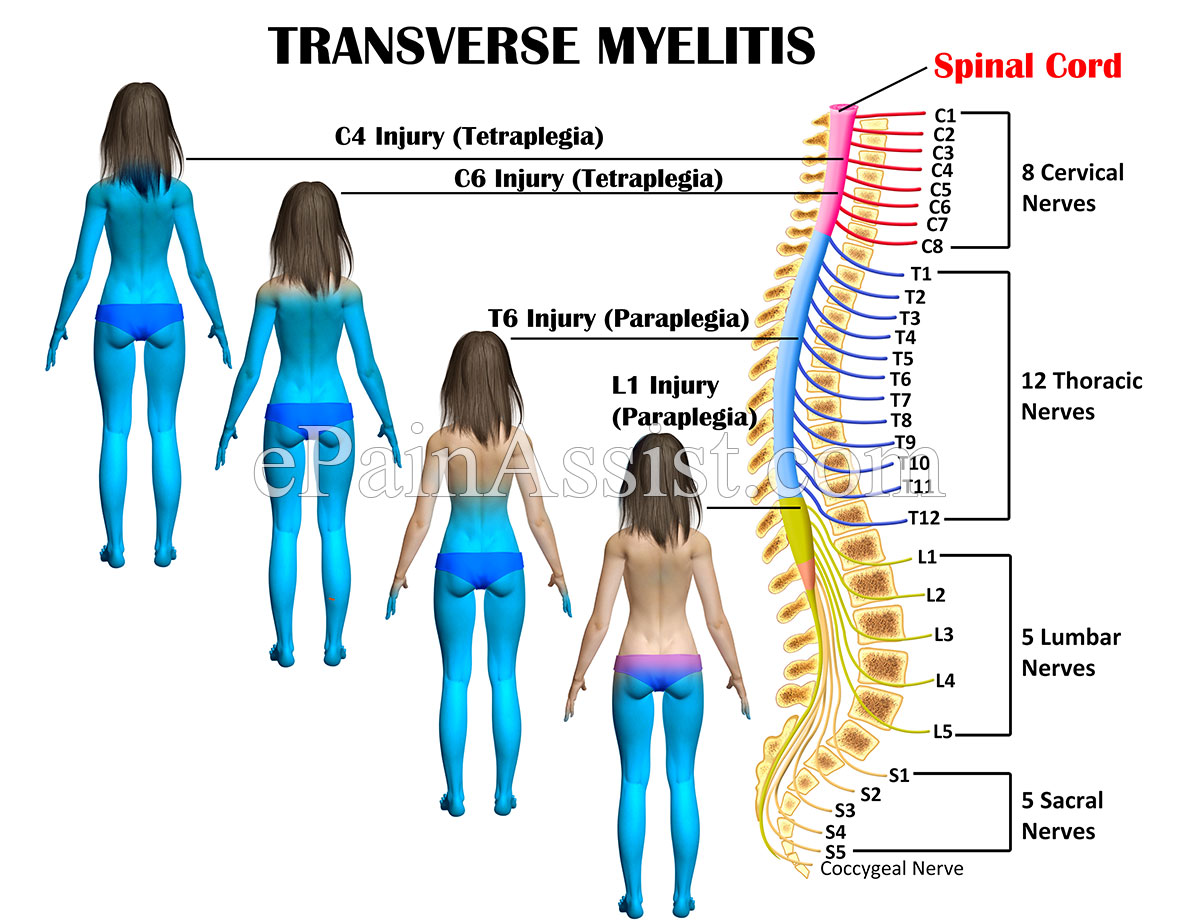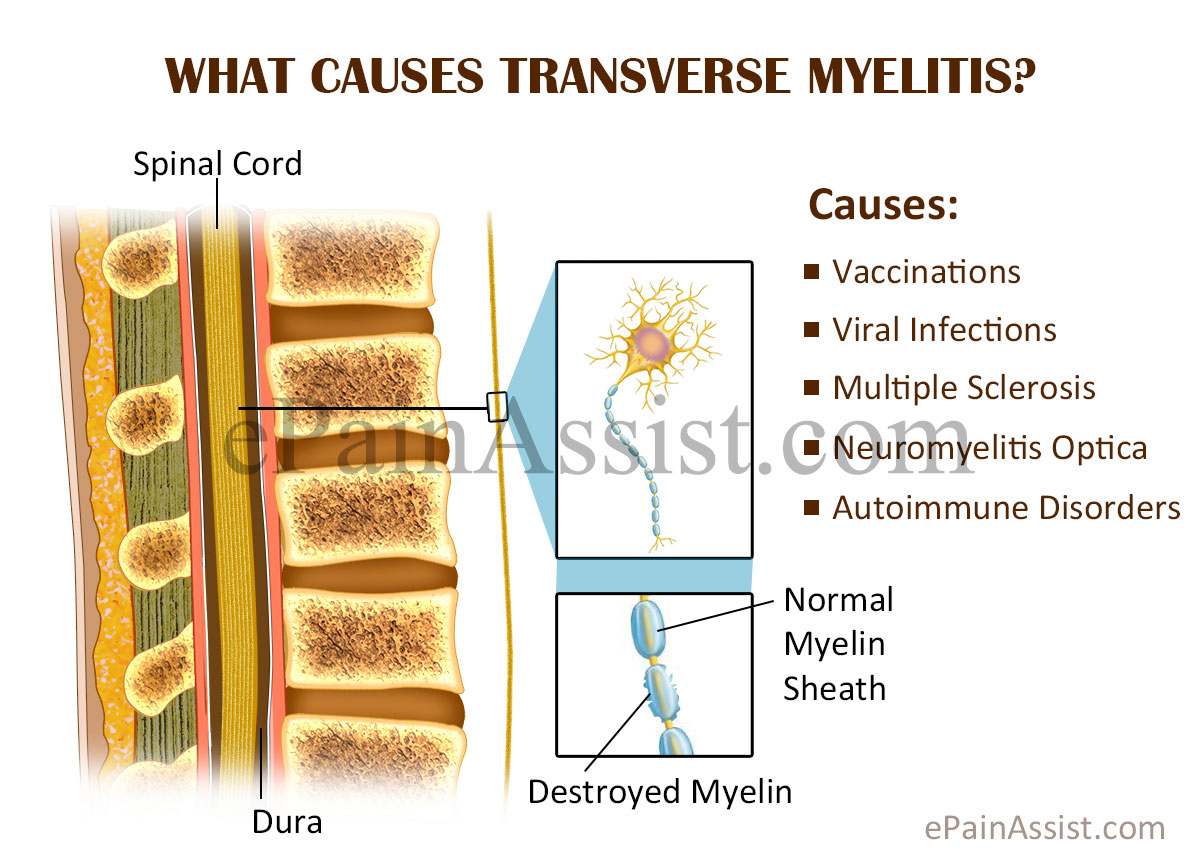What is Transverse Myelitis?
Transverse Myelitis is a pathological condition in which there is inflammation in the spinal cord normally targeting the myelin.1 Myelin is a material which covers the nerve cell fibers. This condition can result in damage across the spinal cord due to which there may be sensory disturbance below the region of the injury. Other problems that can be caused due to Transverse Myelitis can be severe back pain, sensory disturbances as mentioned above, weakness of the muscle, paralysis and bowel and bladder dysfunction. There are numerous causes for Transverse Myelitis some of which include viral infections or immune system dysfunction. Medical condition like Multiple Sclerosis can also be a cause of Transverse Myelitis. This condition is normally treated with antiinflammatory medications for control of symptoms and extensive rehabilitation program. Majority of people with Transverse Myelitis tend to have complete recovery but in extreme cases people may be left with major disabilities.

What Causes Transverse Myelitis?
The root cause of Transverse Myelitis is still a mystery and in some cases there is no cause ever found for this condition, although there are some causes which have been attributed to development of Transverse Myelitis.2 These causes are:

Viral Infections: Viral infections of the respiratory tract and the GI tract have been shown to cause Transverse Myelitis with this condition developing after being fully recovered from the infection. There are some types of viruses that directly affect the spinal cord like the herpes virus, herpes zoster virus, West Nile virus and the like.2
Multiple Sclerosis: Disease like multiple sclerosis is known to cause Transverse Myelitis as this is a disorder that tends to destroy the myelin in the spinal cord and the brain. In fact, in some cases Transverse Myelitis is a defining symptom of Multiple sclerosis.
Neuromyelitis Optica: This is also a medical condition which is known to cause Transverse Myelitis. This condition results in myelin loss around the spinal cord.
Autoimmune Disorders: Certain autoimmune disorders have also been known to cause Transverse Myelitis. Some of the disorders are lupus or Sjogren’s syndrome.
Vaccinations: In some cases vaccinations for various diseases have also caused Transverse Myelitis. Some of the vaccinations causing this condition are vaccinations for hepatitis B, MMR vaccination, diphtheria, and tetanus vaccines.
What are the Symptoms of Transverse Myelitis?
An individual with Transverse Myelitis may experience symptoms as early as within a couple of hours of development of this condition with progressive worsening of the symptoms over the ensuing days. Depending on the cause of the disease, the symptoms may affect one or both sides of the body. Some of the symptoms experienced by an individual with Transverse Myelitis are:
Severe Pain: Pain due to Transverse Myelitis is generally of sudden onset in the neck or back depending on the area where the spinal cord has been affected. These pains may radiate down the legs or hands. Pain may also be experienced in and around the abdomen.
Sensory Alterations: In some cases people with Transverse Myelitis may experience numbness, tingling, sense of coldness, or burning of the upper and lower extremities. There may be hypersensitivity to touch.2
Weakness of Extremities: Another classic symptom of Transverse Myelitis is weakness of the muscles of the upper and lower extremities. The weakness may be such that some people may even drag their foot to ambulate and may even require use of assistive devices to prevent falling due to weakness of the leg muscles.
Bladder and Bowel Dysfunction: Individuals with Transverse Myelitis may experience increased urinary urgency and frequency, incontinence and constipation.2
How is Transverse Myelitis Diagnosed?
In order to diagnose Transverse Myelitis, the physician will take a detailed history of the patient as to when the symptoms first started and whether there is any history of viral infections just before the symptoms started. The physician will also check the function of the nerves with different tests. Some of the tests conducted to confirm the diagnosis of Transverse Myelitis are:
MRI Scan of the Spinal Cord: This will clearly give an image as to whether there is inflammation of the spinal cord or not.2
Lumbar Puncture: Also known by the name of spinal tap, in this test a needle is used to draw a little bit of cerebrospinal fluid from the spinal column and is sent for analysis. If the patient has Transverse Myelitis, then the cerebrospinal fluid will contain abnormally high levels of white blood cells pointing towards an inflammation.
Blood Tests: These may be done to rule out conditions like neuromyelitis optica.2
How is Transverse Myelitis Treated?
There are different treatment options available for treating Transverse Myelitis. Some of the treatment modalities are:
Treating Transverse Myelitis with IV Steroids: IV steroids are normally used to calm down the inflammation and hence control the symptoms.
Treating Transverse Myelitis with Plasma Exchange: This therapy is done for people who do not show a favorable response to steroid therapy. In this therapy, the plasma is removed and replaced with fluids which control the inflammation and treats the condition. How Plasma Exchange helps in treatment is not exactly clear but literature suggests that the exchange removes all the antibodies that are responsible for inflammation of the spinal cord.
Treating Transverse Myelitis with Antiviral Medications: If Transverse Myelitis is caused due to a viral infection, then this therapy is useful in calming down the symptoms caused by Transverse Myelitis.
Pain Medication: Antiinflammatories and pain medications in the form of ibuprofen or Tylenol are given to control pain caused by Transverse Myelitis.
Antidepressants: In some cases, pain present in the nerves may be treated with certain antidepressants like Zoloft or an anticonvulsant like Neurontin.
Certain medications may also be prescribed to control the symptoms like muscle weakness and other symptoms that are caused by Transverse Myelitis.
Apart from pharmacological therapy, non-pharmacological treatments are also given for treatment of Transverse Myelitis. These treatments are:
Physical Therapy: This is done to improve strength and coordination of the muscles so that the patient has a better quality of life and is not dependent on external devices to carry out his or her activities
Occupational Therapy: This therapy aims at training patients on how to perform day to day activities with the symptoms.
Psychotherapy: This is done to help the patient cope up with the disease condition until it is resolved.
What is the Prognosis of Transverse Myelitis?
In majority of the cases of Transverse Myelitis, the patients recover most of their strength and endurance back but the recovery process of Transverse Myelitis may take up to a year or may be ever more. Majority of the recovery will take place within the first three months of the onset of symptoms.
In case if a patient does not recover from Transverse Myelitis, they may end up having certain disabilities which can be moderate in which they may be left with ambulatory difficulties, persistent numbness and tingling of the extremities, and bowel or bladder dysfunction. Some percentage of people may have severe disabilities and may end up being dependent on a wheelchair for ambulation and performing day to day activities after an attack of Transverse Myelitis.
Literature suggests that people who have a slow onset of Transverse Myelitis tend to have a better prognosis than people who have rapid onset Transverse Myelitis.
